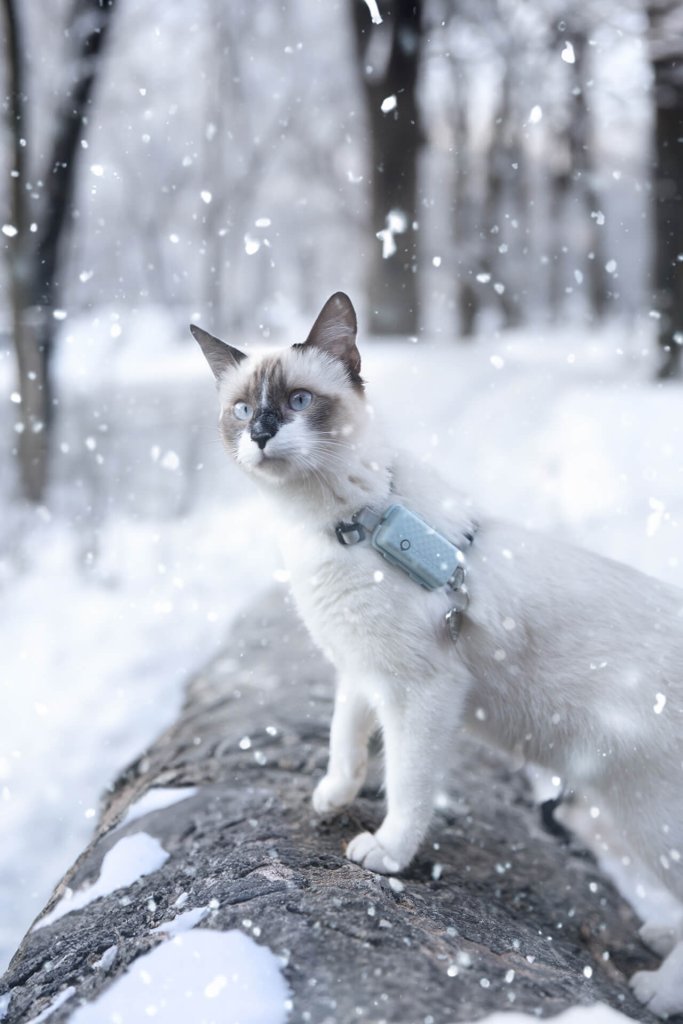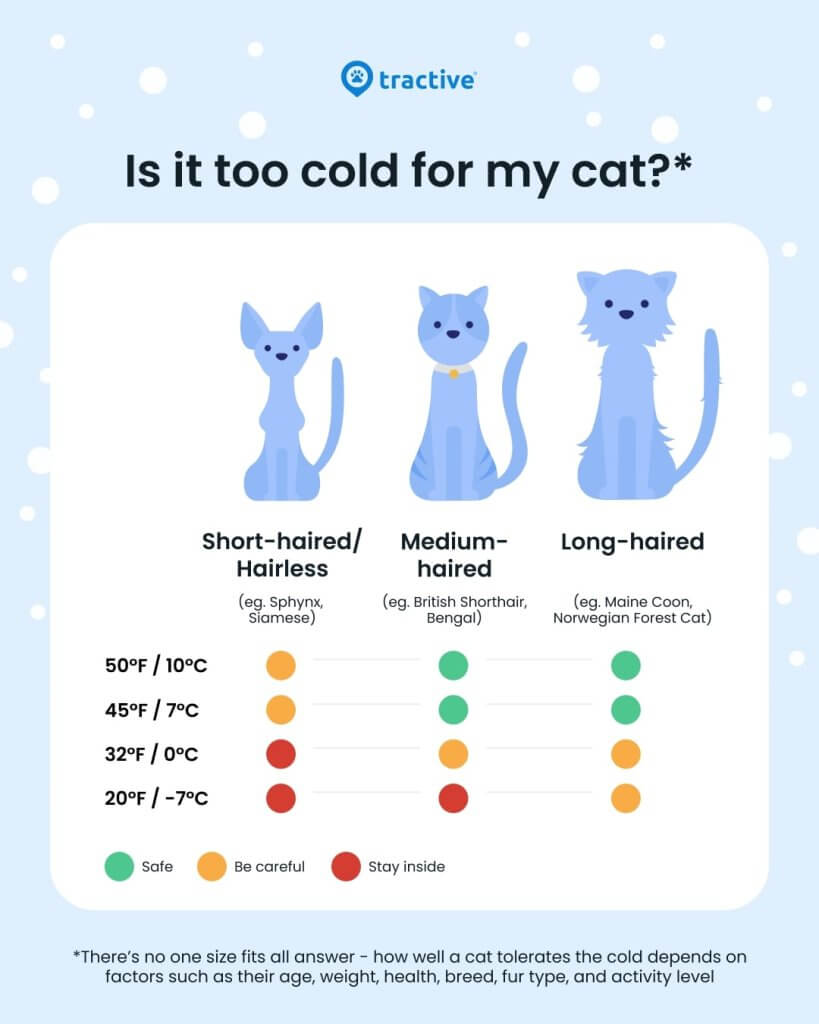How Cold Is Too Cold For Cats?
When cold weather comes, it brings another potential danger for our outdoor feline friends. That's why it's crucial to know how cold is too cold for cats, and when to keep your pet indoors.
As winter approaches, you may start to wonder how much cold your feline friend(s) can handle. While cats have natural instincts and adaptations that help them survive in different environments, extreme cold can still be dangerous for them. Knowing how cold is too cold for cats can help you keep your pet safe and comfortable during the winter months.
In this post, we’ll cover the ideal (and dangerous) temperature range for cats, signs that your cat is cold, and tips to ensure your furry companion stays warm and safe in winter.
And while you’re here, don’t forget to checkout our guide on caring for outdoor cats in winter.
Quick Summary
How well cats can tolerate the cold depends on several factors, such as their age and breed. At temperatures below 45°F (7°C), cats are at risk of cold-related illnesses. Signs that your cat is too cold include shivering, seeking shelter, and decreased activity. Provide warm, dry places for your indoor or outdoor cat to retreat to during cold weather. Cats with short fur or those with health issues may need extra protection during chilly months. A GPS & health tracker for cats can help you keep your feline friend safe and healthy.

Find out where your cat spends their time.
Read moreUnderstanding a cat’s cold tolerance
Cats are generally resilient animals and are known to seek out warmth during colder weather. However, they have their limits when it comes to how much cold they can handle.
According to the American Veterinary Medical Association, cats do best within a temperature range of 10°C and 26.5°C (50°F – 80°F).1
If the temperature dips below 45°F (7°C), cats can start to feel the effects of the cold, and prolonged exposure can lead to hypothermia or frostbite.
While some outdoor cats may be more accustomed to colder weather, it is important to remember that most domestic cats are not suited for extreme cold. Indoor cats, in particular, are much more sensitive to cold temperatures, as they may not have the necessary thick coats or natural insulation to survive outdoors during the winter.

A Tractive GPS & Health Tracker for cats tracks your cat 24/7, so you can find them and bring them inside if necessary. Besides GPS location tracking, it also monitors your cat’s activity and sleep and alerts you if something seems off.
How cold is too cold for cats?
There’s no one size fits all answer – how well a cat tolerates the cold depends on factors such as their age, weight, health, breed, and fur type. Here’s a general rule of thumb:
| 45°F (7°C) or Above: | At this temperature range, most cats can comfortably stay outside for short periods. However, it’s still important to ensure that they have access to shelter, food, and fresh water. Cats that live outdoors, especially those with thicker coats, may tolerate these temperatures better. Indoor cats, on the other hand, should be kept in a warm environment at all times. |
| 32°F (0°C): | At freezing temperatures, it’s important to bring your cat inside if it is an outdoor cat. Cats at this temperature are at risk for hypothermia, especially if they are wet or exposed to the elements for extended periods. Frostbite can also occur if their ears, paws, or tail are exposed to the cold for too long. |
| Below 32°F (0°C): | Once the temperature drops below freezing, it is considered too cold for any cat to be outside. Prolonged exposure to these conditions can lead to severe health problems like frostbite and hypothermia. Even cats with thick fur coats are not equipped to survive such cold temperatures without shelter, food, and warmth. |
Cold temperature for cats by fur type
The type of fur a cat has is an important factor in how well they can tolerate the cold. So we put together this guide to help you determine what to do with your cat in various cold temperatures depending on their hair type.
Keep in mind this is just a guide – and whether or not it’s too cold for your cat will depend on many factors.
How to tell if your cat is too cold
Cats are great at hiding discomfort, but there are signs that indicate they might be too cold. Watch for these behaviors and symptoms:
- Shivering or trembling: Just like humans, cats shiver when they are cold as their bodies try to generate warmth.
- Curling up or huddling: Cats instinctively curl into a tight ball to conserve body heat when they are cold.
- Seeking warmth: If your cat suddenly starts crawling under blankets, sitting on heat sources, or trying to get closer to you, it’s a sign they are looking for warmth.
- Purring excessively: While cats purr for many reasons, excessive purring can sometimes indicate that they are trying to warm themselves up.
- Lethargy: If your cat is unusually sluggish or lethargic, it could be a sign of cold stress.
- Cold ears or paws: Touch your cat’s ears and paws. If they feel cold to the touch, it’s a good indication they are too cold.
If you notice any of these signs, it’s important to take action to warm up your cat immediately and provide a warm environment for them to recover.

Get health alerts for your cat
Our cats can’t always tell us if something’s wrong. But if their tracker detects unusual changes in their routine, you’ll get an alert, helping you catch potential issues early.
Tips to keep your cat safe in cold weather
Now that we’ve established how cold is too cold for cats, let’s discuss some practical tips for keeping your furry friend warm and safe during the winter months.
1) Bring your cat inside
The most important step you can take to protect your cat from the cold is to bring them inside during chilly weather. Indoor cats are safer from the dangers of extreme temperatures, as they have access to heat sources, cozy places to curl up, and plenty of food and water.
If your cat is an outdoor cat, consider providing them with a insulated shelter or heated cat house where they can take refuge when it gets too cold outside.
2) Provide warm bedding
Cats love warmth, and providing them with soft, warm bedding is one of the best ways to keep them comfortable. Consider placing a heated cat bed or an electric heating pad under a blanket to create a cozy spot. If you don’t have a heated bed, regular blankets, towels, or even a pile of clothes can offer extra warmth.
Be sure to check the bedding regularly to ensure it’s dry and comfortable.
3) Limit outdoor time
If your cat is used to being outdoors, limit the amount of time they spend outside during extreme cold. It’s okay to let them explore for a short time, but don’t let them stay outside for hours in freezing conditions. Try to bring them back inside when the temperature drops too low.
4) Monitor your cat’s health
Cold weather can have a negative impact on your cat’s overall health. Make sure your cat is eating regularly and staying hydrated, as cold weather can cause their metabolism to slow down. Check their paws for frostbite or other injuries, and be mindful of any changes in behavior, like increased shivering or lethargy.
PRO TIP: You can monitor your cat’s location, activity levels, and sleep with a Tractive GPS Cat Tracker.
5) Use pet-safe heating solutions
If you’re worried about your cat staying warm in cold weather, you can use pet-safe heating solutions like electric heating pads or heated mats. Just make sure to supervise them to avoid any potential risks like burns or electrical accidents. Avoid using regular space heaters, as they can get too hot for your cat and pose a safety risk.
6) Watch out for snow and ice
If your cat spends time outdoors during snowy weather, be sure to watch out for ice and snow accumulation on their paws. This can cause discomfort and even injury if they walk on icy surfaces for too long. You can apply a thin layer of pet-safe paw wax to protect their paws from ice and snow.
What to do if your cat is exposed to extreme cold
If your cat has been exposed to extreme cold for too long, it’s important to act quickly to prevent serious health issues. Here’s what to do:
- Warm them up gradually: Don’t try to warm your cat up too quickly, as this can cause shock. Use a warm blanket or towel to wrap them up and let their body heat come back slowly.
- Check for frostbite: Inspect your cat’s ears, paws, and tail for signs of frostbite. If you notice any pale or swollen areas, seek immediate veterinary care.
- Take them to the vet: If your cat shows signs of hypothermia (shivering, lethargy, pale gums), contact a vet immediately. Prompt medical care is essential in these cases.
Cold temperatures for cats: FAQs
Temperatures below 45°F (7°C) are considered too cold for cats to be outside for extended periods. Anything below freezing (32°F/0°C) is dangerous for them.
Signs include shivering, curled-up posture, seeking warmth, lethargy, and cold ears or paws.
Outdoor cats can survive winter if they have shelter, food, and warmth. However, extreme cold should be avoided, and they should be brought inside when the temperature drops too low.
Bring them inside immediately, provide warm bedding, and monitor for signs of hypothermia or frostbite.
Yes, pet-safe heating pads can be used to keep your cat warm. Just make sure they are monitored to prevent burns or accidents.
It’s best to limit outdoor time during the winter months and ensure your cat has access to warm shelter and food.
Conclusion
In conclusion, understanding how cold is too cold for cats is vital for keeping your furry friend safe and healthy during the winter months. While cats have some natural ability to tolerate cold, they are still vulnerable when exposed to freezing temperatures. By taking the proper precautions, you can ensure that your cat stays safe, comfortable, and happy in colder weather.





